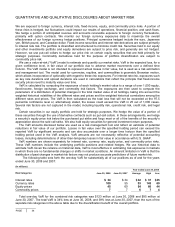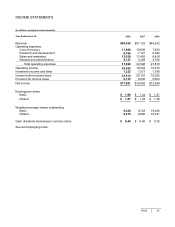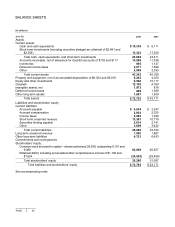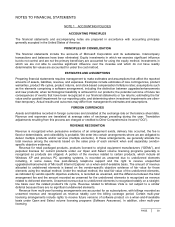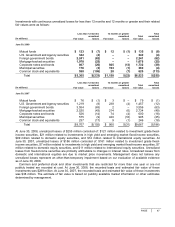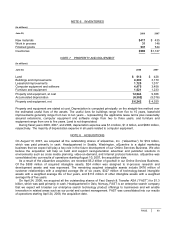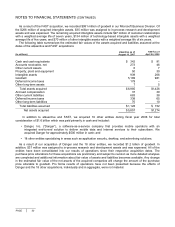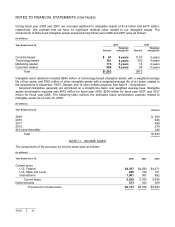Microsoft 2008 Annual Report Download - page 43
Download and view the complete annual report
Please find page 43 of the 2008 Microsoft annual report below. You can navigate through the pages in the report by either clicking on the pages listed below, or by using the keyword search tool below to find specific information within the annual report.
PAGE 42
NOTES TO FINANCIAL STATEMENTS (CONTINUED)
Foreign Currency Risk. Certain assets, liabilities, and forecasted transactions are exposed to foreign currency
risk. We monitor our foreign currency exposures daily to maximize the overall effectiveness of our foreign
currency hedge positions. Options are used to hedge a portion of forecasted international revenue for up to three
years in the future and are designated as cash-flow hedging instruments under Statement of Financial Accounting
Standards (“SFAS”) No. 133, Accounting for Derivative Instruments and Hedging Activities. Principal currencies
hedged include the euro, Japanese yen, British pound, and Canadian dollar. Certain non-U.S. dollar denominated
securities are hedged using foreign exchange forward contracts that are designated as fair-value hedging
instruments under SFAS No. 133. Certain options and forwards not designated as hedging instruments under
SFAS No. 133 are also used to hedge the impact of the variability in exchange rates on accounts receivable and
collections denominated in certain foreign currencies and to manage other foreign currency exposures.
Equities Price Risk. Equity investments are subject to market price risk. From time to time, we use and
designate options to hedge fair values on certain equity securities. We determine the security selected for
hedging by evaluating market conditions, up-front costs, and other relevant factors. Certain options, futures, and
swap contracts, not designated as hedging instruments under SFAS No. 133, are also used to manage equity
exposures.
Interest Rate Risk. Fixed-income securities are subject to interest rate risk. The fixed-income portfolio is
diversified and consists primarily of investment grade securities to minimize credit risk. We use exchange-traded
option and futures contracts and over-the-counter swap contracts, not designated as hedging instruments under
SFAS No. 133, to hedge interest rate risk.
Other Derivatives. Swap contracts, not designated as hedging instruments under SFAS No. 133, are used to
manage exposures to credit risks, enhance returns, and to facilitate portfolio diversification. In addition, we may
invest in warrants to purchase securities of other companies as a strategic investment. Warrants that can be net
share settled are deemed derivative financial instruments and are not designated as hedging instruments. “To Be
Announced” forward purchase commitments of mortgage-backed assets are also considered derivatives in cases
where physical delivery of the assets is not taken at the earliest available delivery date. All derivative instruments
not designated as hedging instruments are recorded at fair value, with changes in value recognized in earnings
during the period of change.
ALLOWANCE FOR DOUBTFUL ACCOUNTS
The allowance for doubtful accounts reflects our best estimate of probable losses inherent in the accounts
receivable balance. We determine the allowance based on known troubled accounts, historical experience, and
other currently available evidence. Activity in the allowance for doubtful accounts was as follows:
(In millions) 2008
2007 2006
Y
ear Ended June 30,
Balance, beginning of period $117
$142 $171
Charged to costs and expenses 88
64 40
Write-offs and other (52)
(89) (69)
Balance, end of period $153
$117 $142
INVENTORIES
Inventories are stated at the lower of cost or market, using the average cost method. Cost includes materials,
labor, and manufacturing overhead related to the purchase and production of inventories. We regularly review
inventory quantities on hand, future purchase commitments with our suppliers, and the estimated utility of our
inventory. If our review indicates a reduction in utility below carrying value, we reduce our inventory to a new cost
basis.




